Marrying Vega and Zen: The AMD Ryzen 5 2400G Review
by Ian Cutress on February 12, 2018 9:00 AM ESTiGPU Gaming Performance, Continued
Rise of the Tomb Raider
One of the most comprehensive games in the gaming benchmark suite is Rise of the Tomb Raider (RoTR), developed by Crystal Dynamics, and the sequel to the popular Tomb Raider which was loved for its automated benchmark mode. But don’t let that fool you: the benchmark mode in RoTR is very much different this time around.
Visually, the previous Tomb Raider pushed realism to the limits with features such as TressFX, and the new RoTR goes one stage further when it comes to graphics fidelity. This leads to an interesting set of requirements in hardware: some sections of the game are typically GPU limited, whereas others with a lot of long-range physics can be CPU limited, depending on how the driver can translate the DirectX 12 workload.

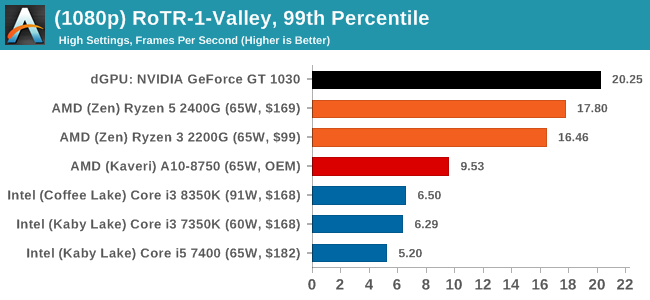
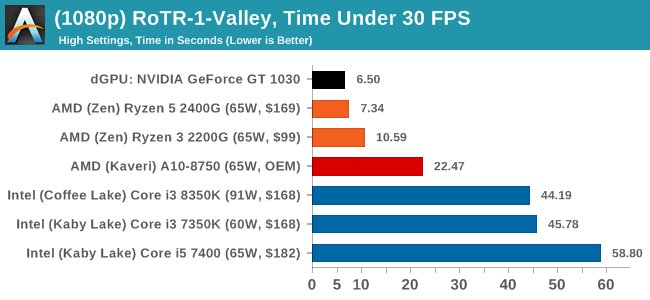
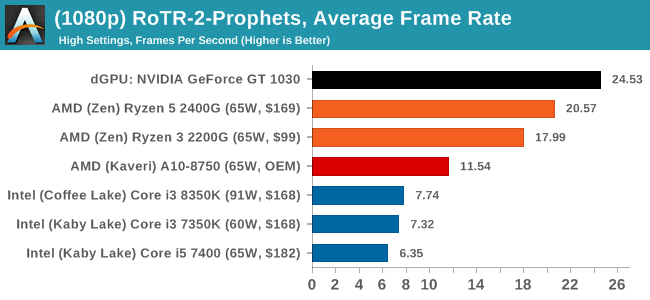
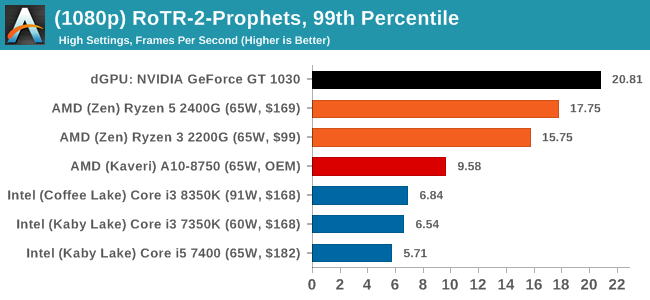
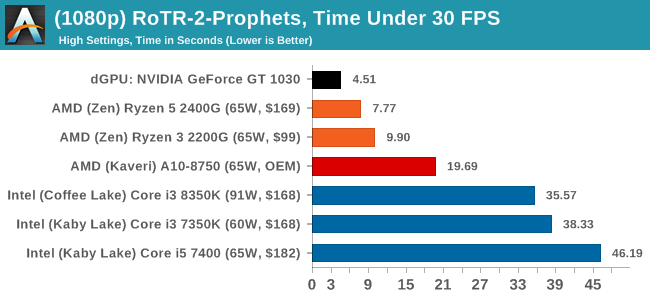

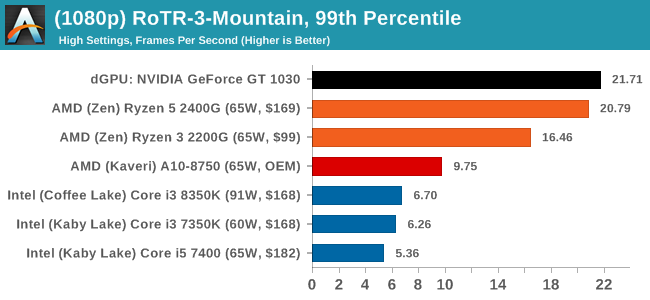
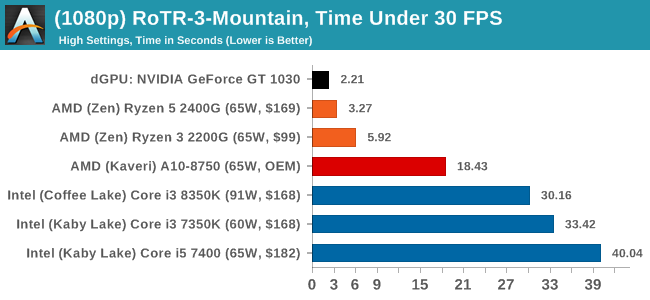
The GT 1030 sweeps the top spot against AMD here, though only by small margins most of the time. The AMD APUs still offer a commanding 2-3x performance jump over Intel's product line, and even more when price is factored into the equation.
Rocket League
Hilariously simple and embodying the elements of pick-up-and-play, Rocket League allows users to jump into a game with other people (or bots) to play football with cars with zero rules. The title is built on Unreal Engine 3, which is somewhat old at this point, but it allows users to run the game on super-low-end systems while still taxing the big ones. Since the release in 2015, it has sold over 5 million copies and seems to be a fixture at LANs and game shows. Users who train get very serious, playing in teams and leagues with very few settings to configure, and everyone is on the same level. Rocket League is quickly becoming one of the favored titles for e-sports tournaments, especially when e-sports contests can be viewed directly from the game interface.
With Rocket League, there is no benchmark mode, so we have to perform a series of automated actions, similar to a racing game having a fixed number of laps. We take the following approach: Using Fraps to record the time taken to show each frame (and the overall frame rates), we use an automation tool to set up a consistent 4v4 bot match on easy, with the system applying a series of inputs throughout the run, such as switching camera angles and driving around.
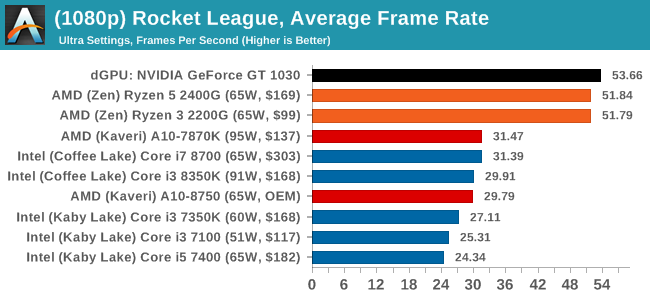
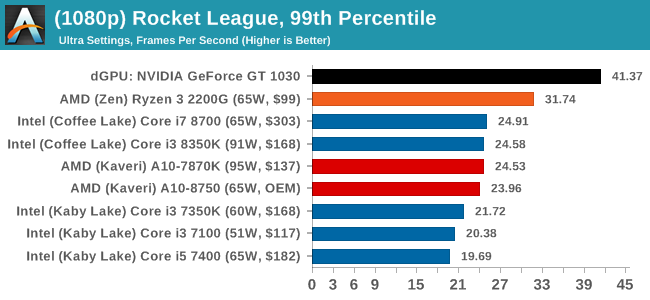

As the more eSports oriented title in our testing, Rocket League is less graphically intense than the others, and by being built on DX9, also tends to benefit from a good single thread performance. The GT 1030 wins again here, most noticably in the 99th percentile numbers, but the AMD chips are hitting 30 FPS in that percentile graph, whereas in the last generation they were getting 30 FPS average. That is a reasonable step up in performance, aided both to the graphics and the high-performance x86 cores. It will be interesting to see how the memory speed changes the results here.










177 Comments
View All Comments
AndrewJacksonZA - Monday, February 12, 2018 - link
Hi Ian. I'm still on page one but I'm so excited! Can a 4xx Polaris card be Crossfired with this APU?prtskg - Tuesday, February 13, 2018 - link
No crossfire supported by these apus, according to AMD. You can check it out on AMD's product page.dgingeri - Monday, February 12, 2018 - link
How many PCIe lanes are available on them? I didn't see that info anywhere in the article.iter - Monday, February 12, 2018 - link
Only 8dgingeri - Monday, February 12, 2018 - link
Well, not great, but it can still run a RAID controller off the CPU lanes and a single port of 10Gbe from the chipset, or run a dual port 10Gbe from the CPU and a lower end SATA HBA from PCIex4 from the chipset with software RAID. The 2200G could make a decent storage server with a decent B350 board. I could do more with 16 lanes, but 8 is still workable. It's far cheaper than running a Ryzen 1200 with a X370 board and a graphics card with the same amount of lanes available for IO use and a faster CPU.Geranium - Monday, February 12, 2018 - link
8 PCIe Gen3 for gpu+4 Gen3 for SSD+4 Gen3 for Chipset.andrewaggb - Monday, February 12, 2018 - link
What's with the gaming benchmarks... Is there a valid reason that no games were benchmarked at playable settings? I'm going to have to go to another site to find out if these can get 60ish fps on medium or low settings.... And I thought these were being pitched at esports... so some overwatch and dota numbers might have been appropriate.AndrewJacksonZA - Monday, February 12, 2018 - link
"and can post 1920x1080 gaming results above 49 FPS in titles such as Battlefield One, Overwatch, Rocket League, and Skyrim, having 2x to 3x higher framerates than Intel’s integrated graphics. This is a claim we can confirm in this review.""These games are a cross of mix of eSports and high-end titles, and to be honest, we have pushed the quality settings up higher than most people would expect for this level of integrated graphics: most benchmarks hit around 25-30 FPS average with the best IGP solutions, down to 1/3 this with the worst solutions. The best results show that integrated graphics are certainly capable with the right settings, but also shows that there is a long way between integrated graphics and a mid-range discrete graphics option."
I would love to see which settings BF1 would have 49FPS please. Is it with everything on low, medium?
Ian Cutress - Monday, February 12, 2018 - link
I've added some sentences to the IGP page while I'm on the road. We used our 1080 high/ultra CPU Gaming suite for two reasons.Manch - Monday, February 12, 2018 - link
Which are?